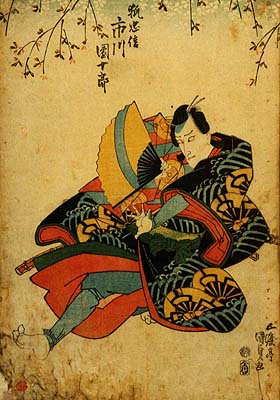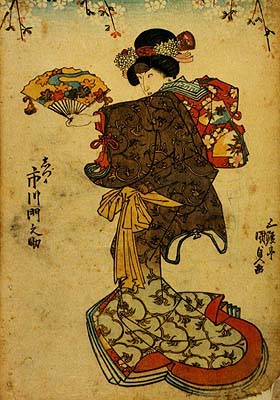| YOSHINOYAMA |
| Play title | Yoshitsune Senbon Zakura Yoshitsune and the Thousand Cherry Trees |
| Authors | Segawa Jok˘ II (lyrics) Tobaya Rich˘ (music) |
| History | The play "Yoshitsune Senbon Zakura" was originally written for the puppets theater and staged for the first time in the 11th lunar month of 1747 in ďsaka at the Takemotoza. It was adapted for Kabuki the following year and staged for the first time in the 1st lunar month of 1748 in Ise with Kataoka Nizaemon IV (Tokaiya Ginpei, Yokawa no Zenji Kakuhan) and Yamamoto Koheiji (Tadanobu). It was performed for the first time in a city licensed theater in the 5th lunar month of 1748, in Edo at the Nakamuraza [casting]. The original michiyuki, which was called "Michiyuki Hatsune no Tabi" and Gidayű-based, was progressively replaced from 1767 by either a Tokiwazu, Tomimoto or Kiyomoto-based michiyuki. "Yoshinoyama", written by Segawa Jok˘ II and Tobaya Rich˘, was staged for the first time in the 5th lunar month of 1808 for the production of "Yoshitsune Senbon Zakura" at the Nakamuraza, starring Nakamura Utaemon III and Segawa Rok˘ IV in the roles of the fox Genkur˘ disguised as Sat˘ Tadanobu and Shizuka Gozen, with a Tomimoto musical accompaniment. Nowadays the musical accompaniment is usually Kiyomoto but There is also a version of the dance which combines both Tokiwazu and Gidayű musical accompaniments. This unusual version was popularized by Ichikawa Ennosuke II and is still performed by his grandson Ichikawa Ennosuke III. |
| Structure | The "Yoshinoyama" (or "Michiyuki Hatsune no Tabi") dance , which is nowadays one of the most frequently performed items of "Yoshitsune Senbon Zakura", is the Michiyuki of the play and the first scene of act IV. |
| Key words |
En'˘ Jűshu Genpei-kassenmono Genji Gidayű Ky˘gen Giri/Ninj˘ Heike Jidaimono Kiyomoto Michiyuki Minamoto Yoritomo Minamoto Yoshitsune Shosagoto Tachimawari Yoshinoyama Yoshitsune Shitenn˘ |
| Summary |
Previous scene: "Sushiya" Michiyuki Hatsune no Tabi When Yoshitsune distinguished himself in battle against the Heike, his half-brother and head of the Genji clan, Yoritomo, felt his own leadership threatened and grew jealous. Eventually Yoritomo sent troops after Yoshitsune, who fled with a small band of his faithful followers. Yoshitsune would not allow Shizuka Gozen, his concubine, to join him in their perilous flight, but gave her a hand-drum as a love token and put her under the protection of his faithful retainer Sat˘ Tadanobu. But, unknown to either of them, this Tadanobu is in reality a fox-spirit that has taken the form of the real Tadanobu, who is taking care of his sick mother. Shizuka, however, is determined to rejoin her lover and sets out after him. Traveling through the mountains, where the cherry trees are in full bloom, she and Tadanobu stop for a rest by a tree in the forest. Suddenly she becomes aware that Tadanobu has disappeared. To console herself she begins to play the hand-drum. At the sound of the drum, he reappears at her side. Thinking that he had been away on a foraging expedition, she is very surprised. They dance together while singers chant the tale of the adventurous journey Shizuka is making for the sake of love. Thinking of Yoshitsune makes her sad. So, to cheer her up, Tadanobu sets up a suit of armor, which they pretend to be Yoshitsune. Yoshitsune had presented the suit of his own armor to the real Tadanobu, when he had earlier prevented Hayami no T˘ta from capturing Shizuka and the hand-drum. Finally, at Shizuka's request, Tadanobu describes for her in dance the heroic death of Sat˘ Tsugunobu, Tadanobu's elder brother. As Tadanobu finishes his narrative, Hayami no T˘ta, who has been tracking Shizuka, appears with his men. Infatuated with Shizuka, he tries to seize her. But when he sees Tadanobu, he loses the courage to attack. Tadanobu springs and bounds just like the fox that he really is, driving T˘ta and his men away. The skins covering the hand-drum which Shizuka carries are those of his parents. And whenever the drum is struck, he is irresistibly drawn to it. Now he follows Shizuka so triumphantly that his true self is revealed in the animal quality of his bounds and gestures. This summary has been written by Watanabe Hisao and edited by Jeff Blair [website] Next scene: "Shi-no-Kiri" |
| Comments |
"There are many michiyuki travel dances in Kabuki but this is one of the most beautiful. The fact that the characters are journeying outdoors presents an excellent opportunity for descriptive lyrics and those from "Yoshinoyama" are certainly very lovely. This is true from the very first entrance of Shizuka on the hanamichi when the Kiyomoto singers describe her hardship finding her way along mountain paths overgrown with grass. The choreography illustrates the lyrics so that we see Shizuka parting the tall grasses as she goes. She is a little startled when a pheasant suddenly takes to the air and we're told that, though the bird's attachment to its chicks is strong, Shizuka's own love for Yoshitsune is no less constant. As she finally makes her way to the main stage the geza musicians play the drum pattern called "kodama", ("echo"), suggesting the gentle murmurs reverberating through the valleys, as well as the steady beats that indicate a fresh breeze over the hills. One suspects that many in the audience don't notice these geza sounds or do not know what they're meant to represent. This is a great pity for they are important in creating the correct atmosphere for the dance." (Paul M. Griffith) |
 |
 |
|
The actors Ichikawa Danjűr˘ VII and Ichikawa Monnosuke III playing the roles of the fox Tadanobu and Shizuka Gozen in the travelling dance (Michiyuki) "Yoshinoyama" of the play "Yoshitsune Senbon Zakura", which was performed in the 5th lunar month of 1822 at the Ichimuraza (print made by Utagawa Kunisada I) |
|
|
|
| Contact | Main | Top | Updates | Actors | Plays | Playwrights | Programs | Links | FAQ | Glossary | Chronology | Illustrations | Prints | Characters | Derivatives | Theaters | Coming soon | News |